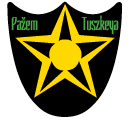Pažem Tuszkeya
| Party of Tuszke Pažem Tuszkeya | |||||||||||||||||||||||||||||||||||||||||||||

| |||||||||||||||||||||||||||||||||||||||||||||
| |||||||||||||||||||||||||||||||||||||||||||||
The Pažem Tuszkeya (S Tuz. /ˈpɑˌʒeɪm ˈtuːzˌkeɪ.jɑ/; sometimes rendered as Pazhem or Pazem; English: Party of Tuszke or sometimes Tuszkean Party; PT or Pažem) is a Kryfona political party, and the major representative of the Tuszke Kryfona within the Kryfona Kingdom. Advocating for Tuszkean nationalism and to a lesser extent civic nationalism, the Pažem is the dominant party among Tuszkeans, and to a lesser extent is supported by Yaraans and the largely-poor and largely-rural Standard Kryfona population of Reriskzeiy Province.
The Pažem Tuszkeya was founded by Derugan Mikoszäkide officially on 29 June, 1960, during the latter stages of the Tuszkean Political Revolution. The Pažem had its roots in the Proper Tuszkeanism movement that had sprung up in the mid-1940s; however, the party's leadership wholeheartedly eschewed the idea and opted for a more general platform in the early days of the party. Less than a year after its founding, the Pažem became the fourth federal party of the Kryfona Kingdom as a part of the United Kryfona Party's Fight for Federality campaign, and in its first election cycle in 1963, the party swept six of Reriskzeiy's seven seats in the Kryfonsparliszaiye. Since then, it has retained at least four seats in every election, with dominance in the far east of the Kingdom and Reriskzeiy in particular. In 1969 and 1975, the party recorded gains of five and two seats, respectively; 1975 also marked the party's high water mark of 13 seats in the Kryfonsparliszaiye. Possibly as a result of its great 1975 showing, the party's headquarters in Keszanetaa was targeted and infamously attacked by Impurists in 1976, leading to the deaths of 12 people, including two of the party's standing PMs at the time. In response, the party launched the Kryfonsparliszaiye seat boycott along with the Yaraan Kryfon's Movement in an effort to garner a response from the government―the campaign was ultimately a success.
Nevertheless, in the next elections, which were held in 1981, the Pažem saw a massive drop in support, much of which was attributed to fears surrounding the Impurists and apparent backlash to the party in the aftermath of the boycott. In the 1981 elections, the party lost 9 seats and posted its worst result in history, retaining only its city seats and losing the rural parts of Reriskzeiy to the Loyalists. The party won two rural seats back in 1987, and the other in 1993 to regain control of all of Reriskzeiy's seats, but subsequently stagnated in the following three elections. In 2011, the party exploded to an impressive 12 seat result―their best since 1975―and swept both Reriskzeiy and the province of Vyfarla-sa-Eiwen, which they had not done since 1975.
The Pažem Tuszkeya is the other member and current leader of the Secessionist bloc in the Kryfonsparliszaiye, having established the bloc with the Yaraan Kryfon's Movement in 1975. The bloc is a member of the United Kryfona Party's government in the Kryfonsparliszaiye, and has been since the UKP won a plurality in the 2005 elections. As of the 2011 elections, the Secessionist bloc is of a comparable size to the United Kryfona Party, and is almost equal in size to the official opposition of the Royalists and Loyalists.
History
Climate in Tuszke
Although it was founded in 1960, the groundwork for the Pažem Tuszkeya had been lain a little over twenty years before it, and well before its original leader Derugan Mikoszäkide got into politics himself. The Pažem's leadership grew up in the 1930s and early 1940s, during which time Tuszke was undergoing something of a political shift. Although it federally elected a loyalist to every seat in Reriskzeiy between 1927 and 1945―the period in which this great shift took place―there was a great change in the thinking of the Tuszkean majority of the province, and this change manifested itself in the rise of Tuszkean radical politics and the push against it from the far-right in the Eporisya Malosom and the rebuffing of radical politics by King Xeriren Awaseq.
Pre-1940
The Tuszkean Political Revolution had by 1928 entered a new, considerably more deadly phase from the early days in which there were a number of peaceful campaigns and a weak opposition against the campaigns. The Eporisya Malosom began in earnest a campaign of bombings, firebombings, and political assassinations in 1926, but these were few and far between until the Tuszkean Acts of 1927 were passed, and the Royalists were dealt something of a blow when they fell to just 36 seats of 81 in the subsequent elections. After these two events, the Eporisya Malosom kicked its campaign into high gear, and began to attack targets within Reriskzeiy, where the left-wing was surging and revolutionary politics had begun to take their place in the Parliament.
Firebombings were not uncommon in the 1930s in Tuszke, and assassinations on behalf of the Eporisya Malosom seemed to take place almost every other week. In the course of six years, virtually every significant newspaper or publication in the province of Reriskzeiy was targeted by the Eporisya Malosom in some capacity. The Tuszkean Free Press, Tuszkean Independent, and Zarjeňehu Tuzkeya in particular were targeted due to their connotations as "revolutionary" papers, and were repeatedly firebombed and had their journalists targeted. These actions by the Eporisya Malosom only inflamed the sentiments of radical Tuszkeans, and by 1934 the far-left in Tuszke was surging even more-so than the traditional left. The first proper Tuszkean parties, namely the Tuszkean Free Party and the later Radicals for Tuszke, were far-left leaning and established as part of a "first wave" of Tuszkeans who would define the generation of Tuszkean politics.
It was in this early environment that the first of the Pažem Tuszkeya's eventual leadership entered politics. First secretary to the party Veike Tavože was the first of the major members to enter the political realm, joining the Tuszkean Free Party in early 1937 at the age of 16.
Kryfonsparliszaiye history
| Kryfonsparliszaiye | Leader | King | Government | |||||
|---|---|---|---|---|---|---|---|---|
| 1963 | 6 / 81
|
Derugan Mikoszäkide | Tyeri Awaseq | Opposition member | ||||
| 1969 | 11 / 81
|
|||||||
| 1975 | 13 / 81
|
Secessionist member | ||||||
| 1981 | 4 / 81
|
Derýsa Mikoszäkide | ||||||
| 1987 | 6 / 81
|
|||||||
| 1993 | 7 / 81
|
Ghrodinh Virkozsilixaniz | ||||||
| 1999 | 7 / 81
|
|||||||
| 2005 | 7 / 81
|
Rožha Keräň | Secessionist member (Gov. coalition member) | |||||
| 2011 | 12 / 81
|
Secessionist leader (Gov. coalition member) | ||||||
See also
| |||||||||||||
